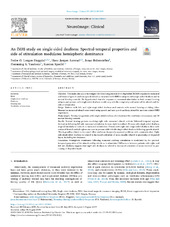| dc.contributor.author | Heggdal, Peder Olaf Laugen | en_US |
| dc.contributor.author | Aarstad, Hans Jørgen | en_US |
| dc.contributor.author | Brännström, Jonas | en_US |
| dc.contributor.author | Vassbotn, Flemming | en_US |
| dc.contributor.author | Specht, Karsten | en_US |
| dc.date.accessioned | 2020-03-13T14:23:47Z | |
| dc.date.available | 2020-03-13T14:23:47Z | |
| dc.date.issued | 2019 | |
| dc.Published | Heggdal POL, Aarstad HJ, Brännström J, Vassbotn F, Specht K. An fMRI-study on single-sided deafness: Spectral-temporal properties and side of stimulation modulates hemispheric dominance. NeuroImage: Clinical. 2019;24:101969 | eng |
| dc.identifier.issn | 2213-1582 | |
| dc.identifier.uri | https://hdl.handle.net/1956/21497 | |
| dc.description.abstract | Objective: Our main aim was to investigate the blood oxygenation level dependent (BOLD) response to monaural and binaural speech- and non-speech stimuli as measured with fMRI in subjects with single-sided deafness and in normal hearing controls. We hypothesised that the response to monaural stimulation in both normal hearing subjects and persons with single-sided deafness would vary with the complexity and nature of the stimuli and the side of stimulation. Design: Patients with left- and right single-sided deafness and controls with normal hearing receiving either binaural or monaural stimuli were tested using speech and non-speech auditory stimuli in an event-related fMRI experiment. Study sample: Twenty-two patients with single-sided deafness after treatment for vestibular schwannoma and 50 normal hearing controls. Results: Normal hearing persons receiving right side monaural stimuli activate bilateral temporal regions. Activation following left side monaural stimulation is more right lateralized. Persons with single-sided deafness respond similarly to controls to monaural stimulation. Persons with right side single-sided deafness show activation of frontal cortical regions not seen in persons with left side single-sided deafness following speech stimuli. This is possibly related to increased effort and more frequently reported problems with communication. Right side single-sided deafness is related to increased activation of areas usually related to processing of degraded input, including the thalamus. Conclusion: Hemispheric dominance following monaural auditory stimulation is modulated by the spectral-temporal properties of the stimuli and by which ear is stimulated. Differences between patients with right- and left side deafness suggests that right side deafness is related to increased activation of areas involved in processing of degraded input. | en_US |
| dc.language.iso | eng | eng |
| dc.publisher | Elsevier | eng |
| dc.rights | Attribution CC BY-NC-ND | eng |
| dc.rights.uri | http://creativecommons.org/licenses/by-nc-nd/4.0/ | eng |
| dc.title | An fMRI-study on single-sided deafness: Spectral-temporal properties and side of stimulation modulates hemispheric dominance | en_US |
| dc.type | Peer reviewed | |
| dc.type | Journal article | |
| dc.date.updated | 2019-11-14T12:53:56Z | |
| dc.description.version | publishedVersion | en_US |
| dc.rights.holder | Copyright 2019 The Author(s) | |
| dc.identifier.doi | https://doi.org/10.1016/j.nicl.2019.101969 | |
| dc.identifier.cristin | 1739250 | |
| dc.source.journal | NeuroImage: Clinical | |

